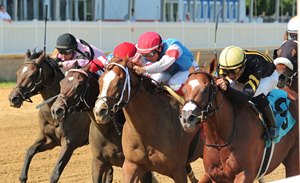Racing at Laurel Remains on Hold, Could Resume Dec. 16


Dec. 16 is targeted for a resumption of racing at Laurel Park while track experts and crews continue to address issues with its main track, Laurel officials told the Maryland Racing Commission during a Dec. 7 meeting. Officials hope horses can begin working on the surface by Dec. 10.
Racing was canceled at the Maryland track earlier this month after a spike in equine fatalities there in November. It was the second time this year that racing at Laurel was halted following an initial occurrence in the spring. Racing then shifted to Pimlico Race Course for an extended meet while Laurel underwent a multi-million dollar track renovation project. The Maryland Jockey Club, which The Stronach Group owns, operates both tracks.
Aidan Butler, chief operating officer for 1/ST Racing, a division of TSG, and Mike Rogers, president of racing at MJC, said favorable reviews initially greeted the new surface. But starting in September officials began receiving feedback of the surface becoming hard and fast. As a result, Rogers noted track crews began harrowing the surface deeper to slow it down. Then this fall officials identified a "slight depression" in the surface near the toteboard, which has been fixed, Rogers said.
According to officials, the surface has been evaluated this month by experts from around the country, including Santa Anita Park track superintendent Dennis Moore, Glen Kozak, senior vice president of operations and capital projects for the New York Racing Association, and Mick Peterson, executive director of the Racing Surfaces Testing Laboratory.
Identified as a potential problem was an area of compressed cushion on the track that Rogers calls the "pad." The track's issues were further complicated this fall when temperatures began to drop, leaving the surface without a "body of cushion that it should hold," Rogers added. He said the track has since added 50 tons of white sand, and MJC has received another 200 tons of that material.
"I think the two major takeaways here is we're going to add body to the cushion with the sand that we're establishing that needs to be done during the colder weather," Rogers said. "And we're going to continue to work this pad, and we've also received and borrowed a couple of pieces of equipment that we know will help keep that pad."
Laurel has already drawn entries for racing Friday, but that card will not take place based on Tuesday's projections. Butler suggested a delay beyond Dec. 16 is possible if track officials and horsemen are not pleased when Laurel reopens for workouts.
Officials did not state if canceled races, including a pair of stakes from Dec. 4, would be rescheduled. They had hoped to run the two stakes Dec. 11.
At times during Tuesday's meeting, the two executives came under fire from certain commissioners, who could not be identified off-camera on a distributed video broadcast. Some speakers encouraged MJC to steer away from data-driven experts and such analysis of Laurel's surface.
Butler responded that he oversees seven dirt surfaces and five racetracks from TSG's holdings.
"I'm not allowed to just leave them to an individual walking on a track and taking an assessment. I have to have some science to back it up," he said.

A speaker also pointed to MJC track superintendent Chris Bosley not being as experienced as more seasoned track superintendents and emphasized getting the input from industry veterans, mentioning John Passero. A longtime track superintendent, Passero previously worked at MJC and NYRA.
Passero, in the audience, spoke up late in the meeting to address the commission.
"All that happened was, as you started withdrawing water, the track cushion failed to do its job. That was the long and the short of it," Passero said of Laurel's track problems. "What is happening now is they're biting back into the cushion—which is a medium and a little bit of a coarser sand that you can walk across the top of—that will stop the horses from hitting the hard 'pan' hard. That's the whole thing in a nutshell. And that's what they're aiming for right now."
David Richardson, executive director of the Maryland Thoroughbred Horsemen's Association, spoke moments later, noting that the MTHA had "secured" Passero, and he had already been on hand to consult with MJC and other track experts. He called it a collaborative effort.
"That's how we get to where we want to be," Richardson said. "We will not race until we all together say that this racetrack is safe."
